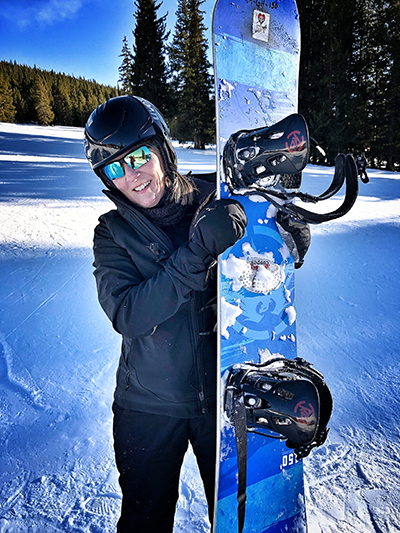Laurelyn Dossett is called many things - singer and songwriter, environmentalist and activist, and mother and grandmother, to name a few. But there is one name she has recently given herself. She says she is the “poster child” for Atrium Health Wake Forest Baptist bilateral hip replacement.

Laurelyn has always been very active. As a seasoned musician whose songs have appeared on Grammy Award-winning albums by other artists, she is often running between performances with instruments in tow. She lives on 40 acres where she often hikes. She also paddleboards, practices yoga, tends two acres of lavender plants and even recently took up snowboarding in her 60s.
For the last 10 years, these activities have been painful at times. Laurelyn says she would stretch and focus on staying in shape, but she eventually sought out a physical therapist.
“I really had trouble getting around the last six months before the surgery. Just basic things like bending over and picking things up, and I had to lift my legs with my hands just to get into the car,” Laurelyn says.
Her physical therapist ordered an x-ray that revealed “bone-on-bone” arthritis, and he immediately referred her to Atrium Health Wake Forest Baptist orthopaedic surgeon Dr. John Shields.
“She had debilitating pain that was holding her back from all the things she wanted to do,” he says. “I tell my patients, when your pain is taking the joy out of the things you love, it’s time for hip replacement surgery.”
Shields performs these surgeries weekly, for patients from their teens to late 90s, and says that total hip replacement is one of the most successful surgeries performed. He recommended double hip replacement for Laurelyn and scheduled her surgeries three months apart. Each surgery took less than an hour at Atrium Health Wake Forest Baptist Davie Medical Center, which rates among the top 10% for joint replacements in the country and was the first in North Carolina to earn the Joint Commission Gold Seal of Approval for joint replacement.
Laurelyn was walking within hours after the surgery and at home with a walker the next day. By the fifth day, she tracked more than five miles on her fitness tracking device.
“I can do everything I did before and things I hadn’t been able to do in a long time,” says Laurelyn. “I am bending and kneeling and picking up heavy things, and I have no limitations.”
She says the thought of her new hips nearly brings her to tears, especially now. Laurelyn’s daughter recently gave birth to her first grandchild, Simon. As Laurelyn threw herself into helping her daughter with his care right after his birth, it occurred to her that she would not be able to help if not for the surgery. And she especially surprised herself when she recently hiked all five peaks in Hanging Rock State Park as a fundraiser for the Stokes County Arts Council – about 13 miles of rough terrain and challenging hills. “I just felt fantastic,” says Laurelyn.
“A lot of people I know really are in significant pain and they say, ‘As long as I can get around and walk, I am going to wait on the surgery.’ I strongly urge people to reconsider, because the longer you let it go, the weaker everything around that joint gets, and the harder the recovery is,” Laurelyn says.
She continues, “I think people have a tendency to think we are going to gradually lose these abilities to get around and that this is normal for aging. This is not normal! This disease process can be corrected and you can go on and be just as active and healthy and vigorous as you would be if you weren’t in pain.”
